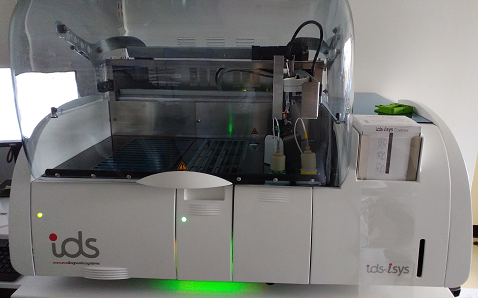METABOLIC MEDICINE AND BONE
Bone Health Clinical Service.
Report for the Institute of Orthopaedics 2020
The bone health service currently has members of staff who work in the laboratory and in the bone density unit. Included in the staffing are consultants, speciality doctors, specialist nurses, a clinical scientist, a metabolic technician, radiographers, a DXA technician and HCAs. In the last financial year we scanned over 8000 patients and over 1400 patients received intravenous treatment for their bones.
In the laboratory over 1300 patient samples were analysed for the bone resorption marker urinary N-telopeptide crosslink of type I collagen (uNTx), a long established marker of bone breakdown as part of the clinical service. The marker is used to monitor treatment efficacy, monitor treatment holidays and to determine baseline bone turnover. Our current research interest is primarily in the use of uNTx to monitor treatment response and the bone response during a drug holiday. We are hoping to submit a paper on the effect of a drug holiday from bisphosphonate treatment on bone turnover, fracture rates and bone mineral density shortly.
In the summer of 2019 we were awarded a grant from the Rheumatology Charity Trust Fund to allow funding to lease an IDS (Immunodiagnostic Systems Ltd) iSYS speciality automated immunoassay analyser. This was granted to allow us to assess the measurement of the bone formation marker PINP (total procollagen type-1 N-terminal propeptide) in the plasma of patients attending our outpatient clinics. Measuring this marker will allow a more complete assessment of bone status in our patients and improve the precision of our clinical decisions including assessing patients on anabolic therapy (parathyroid hormone), whose use is growing in clinical practice. We have measured 870 patient samples up to March 2020. The iSYS system also has the capability to measure other bone markers including CTX-I (C-terminal telopeptide of Type I collagen), a marker of bone resorption. We have evaluated the impact of diurnal variation and fasting on CTX-I in a limited number of clinical samples to assess the utility of the marker in our clinical service.
We were awarded a grant from the Institute Charity to help fund a study to obtain our own reference ranges for both these markers. Ethical approval has been obtained for this and recruiting will hopefully start in the next 12 months.
Figure 1. IDS (Immunodiagnostic Systems Ltd) iSYS speciality automated immunoassay analyser.
Research in the Charles Salt Laboratories.
In last year’s report we mentioned two ongoing studies. The first concerned coeliac disease, a condition associated with gut malabsorption. Whilst low bone density in the spine and hip is well described, issues around appendicular bone density both before and after treatment are less well understood, particularly in women over 50years old. This group is increasingly an age in which coeliac disease is being recognised for the first time and a group which we showed in an earlier paper to be at increased risk of appendicular fractures. Controversy has also existed over whether these patients have low lean body mass due to the disease or whether it is merely associated with the low body weight seen in the patients. We compared patients with coeliac disease with age and weight matched controls and showed that appendicular bone density was significantly lower and that lean mass was also slightly lower, a feature more marked in the upper compared with the lower limb. Some patients were followed up after 7 years. These patients showed no change in appendicular lean mass, but bone density had ceased declining, though it was still below that expected for their age. Coeliac patients in the group that we studied appear to have a deficiency of lean mass that is not corrected by treatment, but the age related decline in bone density is halted but not corrected. These data have been submitted for publication.
Last year we also mentioned a study commenced in 1997 in which we measured bone density in almost 12,000 women aged 50-98yr and our wish to revisit these patients to find out their subsequent treatment persistence and fracture rates. The considerable regulatory issues associated with the ethics of accessing data contained in General Practitioner records for these patients has meant we have not made significant inroads to date in advancing this study.
